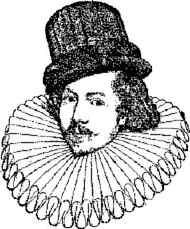Ruffs and hairstyles
The ruff was worn by both men and women. Although Elizabeth wore large ruffs herself, a statute of 1580 forbade neckwear beyond a certain size. Members of the Ironmongers' and Grocers' companies were stationed at Bishopsgate to stop people with "monstrous ruffs" or excessively long cloaks and swords from entering the city. Offenders who refused to change their attire were arrested.
Wigs and beards
Men and women often curled or dyed their hair. On occasion they used false hair or full wigs, making it easier for women to apply elaborate headdresses.
Men's hair was worn in a variety of styles, cut short at the sides, brushed up and held with gum, or curled all over; later in the period long hair came into fashion with men, and was often worn curling to the shoulders and twisted into a "lovelock" on the left side.
Beards* were sometimes dyed to coordinate with an outfit or the wearer's mood. A carnation beard "speckled with green and russett" would mark the return of a loved one, for example.
Footnotes
-
Trade and clothing
Britain's trading supremacy in the 16th century was largely due to the manufacture of cloth; several trading companies were established to sell British cloth around the world. Traders also brought back exotic fabrics, offering a wide variety of woollens, linen, cotton and silks to the Elizabethan consumer.
-
More about beards
Bottom: What beard were I best to play [Pyramus] in?
Quince: Why, what you will.
Bottom: I will discharge it in either your straw-colour beard, your orange-tawny beard, your purple-in-grain [fast dyed] beard, or your French-crown-colour beard, your perfect yellow.
(A Midsummer Night's Dream 1. 2. 88-94)
